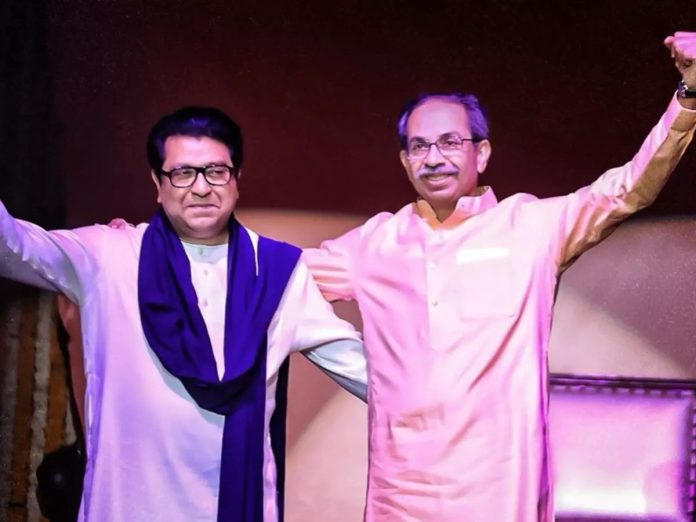– Shahjahan Magdum, Mumbai
The political stage currently unfolding in Maharashtra isn’t merely confined to the struggle for power. In this dramatic turn of events, a vibrant and fresh chapter of Marathi identity is being presented. Uddhav Thackeray and Raj Thackeray recently came together at a rally in Mumbai, and their reunion wasn’t just a display of family closeness; it signalled the beginning of a significant political and emotional shift. When Uddhav Thackeray declared, “Now it’s victory or death,” it wasn’t just an announcement to win an election. It was an oath to rise again, to fight again, and to reclaim rights over an existential question.
Thousands gathered in the calm Mumbai morning. Police had granted permission for the rally at 10 O’clock, but crowds had already started forming before that. This rally wasn’t solely political; it was an attempt to reawaken the dormant Marathi identity. When Uddhav Thackeray said, “We came together to stay together,” those words encompassed past regrets, the tense reality of the present, and future aspirations.
The Brihanmumbai Municipal Corporation (BMC) elections are just a few months away. As always, a battle for political dominance will unfold. But this time, the fight isn’t just for seats; it’s for ideology, identity, and the honour of Marathi existence. This year’s Mumbai Municipal Corporation budget stands at ₹74,427 crore, exceeding the combined budgets of several smaller states. This election isn’t just for local development; it’s an opportunity to demonstrate whose voice holds sway in this city.
A total of 1.24 crore voters will elect 236 corporators. In the last election, the Shiv Sena took the lead by winning 97 seats. However, the Shiv Sena later split. Eknath Shinde broke away party MLAs, formed his own faction, and established a government with the BJP. Subsequently, the Election Commission’s decision transferred the ‘Bow and Arrow’ symbol and the name ‘Shiv Sena’ to the Shinde faction. These developments caused Uddhav Thackeray to lose not only power but also his party’s identity. This situation, a tragically transient moment in politics, paved the way for Uddhav and Raj Thackeray to reunite.
Historical Context and the Resurgence of Marathi Pride
Raj Thackeray is Balasaheb Thackeray’s nephew. At one point, he was considered a successor to the Shiv Sena leadership. But in 2003, Uddhav Thackeray became the Shiv Sena’s working president, and Raj chose a different path. In 2006, he founded the Maharashtra Navnirman Sena (MNS). He initially made a significant impact. In 2009, 13 of his party’s MLAs were elected, and in 2012, 28 corporators were elected in the Mumbai Municipal Corporation. However, in subsequent elections, that enthusiasm waned. With the growing dominance of the BJP, the MNS couldn’t maintain its position.
Against this backdrop, the coming together of the Thackeray brothers carries a serious social implication. There’s a growing sentiment that local Marathi voters are being marginalised due to the increasing expansion of the BJP, particularly its reliance on the Gujarati-North Indian vote bank. Business groups from Gujarat have firmly imprinted their mark on Mumbai’s economic and political power structure. Among Mumbai’s population, 15 percent of Gujarati and North Indian voters solidly back the BJP. On the other hand, the strength of the Marathi people remains divided.
The origins of all this can be traced back to the Samyukta Maharashtra Movement. The British-era Bombay Presidency included Maharashtra, Gujarat, parts of Karnataka, and at one time, even Malabar. In 1956, the Samyukta Maharashtra Samiti launched the struggle for an independent Maharashtra. On November 21, 1955, police opened fire at Flora Fountain (now Hutatma Chowk), and 15 protestors died. This incident gave a decisive turn to the movement. Finally, on May 1, 1960, Maharashtra and Gujarat became independent states, and Mumbai became the capital of Maharashtra.
This struggle wasn’t just about state formation; it was about the self-respect of the Marathi language and culture. The memory of that struggle remains fresh in the minds of the Marathi people. That’s why when Uddhav Thackeray says that Devendra Fadnavis is a modern S.K. Patil, it’s not merely a political comment; it’s a finger pointed at a historical wound.
Historical Parallels and Political Rhetoric
In fact, Uddhav Thackeray’s comparison initially began with Anaji Pant. Anaji Pant was a shrewd official during the Peshwa period who was at the heart of the plot to usurp state power by denying Sambhaji Maharaj’s authority after Chhatrapati Shivaji Maharaj’s death. He was a proponent of the idea of ruling the state without the Chhatrapati. Due to his conspiratorial nature, Maratha power remained directionless for some time. By linking Devendra Fadnavis’s name with Anaji Pant, Uddhav Thackeray implicitly accused him of being someone who “gains power through backhanded means, but without true loyalty to the Chhatrapati, i.e., the power of the people.”
He then compared Fadnavis to S.K. Patil, who, during the Samyukta Maharashtra struggle, advocated for a bilingual state. Patil was then accused of betraying the Marathi people. In the eyes of the Marathi public, S.K. Patil’s name is still associated with those sorrowful memories. Therefore, this comparison wasn’t merely a personal remark; it was an attempt to stir up emotions in the public’s mind once again by touching upon a deep historical wound.
By using examples of both these historical figures, Thackeray attempted to show that Fadnavis is working against the interests of the Marathi people through secretive and anti-people activities. This style isn’t limited to political speeches; it’s a way of appealing to the deep-seated feelings of Marathi identity.
The Shiv Sena’s Legacy and Future Prospects
The history of Shiv Sena is intrinsically linked to the Marathi people’s identity. Bal Thackeray championed the concept of ‘Marathi Manoos’s rights.’ While he didn’t maintain close ties with the RSS, he did utilise Hindutva politically. Balasaheb Thackeray belonged to the Chandraseniya Kayastha Prabhu (CKP) community. During Shivaji Maharaj’s era, the CKP community played a significant role in administration. However, during the Peshwai, Chitpavan Brahmins gained dominance. Many prominent RSS leaders – Savarkar, Hedgewar, Golwalkar, Balasaheb Deoras – were Chitpavan Brahmins. Thus, Bal Thackeray’s Hindutva was an assertion of Marathi identity, utilising Maratha pride.
Against this backdrop, the coming together of Raj Thackeray and Uddhav Thackeray isn’t just a political equation but the dawn of a new public sentiment. There’s a possibility that Marathi voters in urban areas like Mumbai, Thane, Pune, Nashik, and Nagpur will unite again. When Uddhav and Raj Thackeray stand together, addressing these voters, a ray of hope begins to emerge in the minds of Marathi voters.
In the 2024 Lok Sabha elections, the Maha Vikas Aghadi (including Shiv Sena UBT) performed strongly, winning 31 seats, while the Mahayuti secured 17 seats. However, in the recent Assembly elections, the Mahayuti, comprising the BJP, Shinde, and Ajit Pawar factions, achieved significant success, winning over 175 seats. In contrast, Shiv Sena (UBT) only secured 20 seats. The MNS’s influence also remained largely unseen. In such circumstances, the Thackeray brothers face a significant challenge. But by bringing the issue of Marathi identity back to the forefront of political discussion, they have chosen a distinct path.
Fadnavis’s current dominance is strong. He has commented on Marathi culture through his “Maharashtra Dharma” podcast. However, many Marathi people perceive this as mere verbal exercises, lacking genuine sentiment. Marathi voters have learned from experience. Today, they need to be convinced not just by emotional slogans but by concrete actions.
Uddhav Thackeray’s role in the Maha Vikas Aghadi remains crucial. However, internal tensions within the Congress and Nationalist Congress Party directly affect Thackeray’s strategy. In such a situation, the Uddhav-Raj reunification signals the emergence of an independent force.
The Marathi voter remains conscious of preserving their language, culture, tradition, and local selfhood. They desire decisive leadership against external political and social influences. Whether the Thackeray brothers can become this leadership will be seen in the upcoming local self-government elections.
The BMC election could prove to be a decisive moment for Marathi identity. This reunification could breathe new life into Shiv Sena (UBT) and MNS. Its impact could be particularly visible in urban areas like Mumbai and Thane. Nevertheless, this is a war – of emotion, identity, and existence – which is as necessary for striking at power as it is for the re-establishment of one’s own identity.
If this struggle becomes well-organised, a new era will begin in Maharashtra’s politics. But if this reunification remains confined to rallies, speeches, and announcements, the hope generated in the minds of the Marathi people could once again diminish. Therefore, success isn’t just about gaining votes; it’s also about understanding people’s emotions and making them a reality.
[The writer is Executive Editor of “SHODHAN”, the Marathi weekly published from Mumbai]




